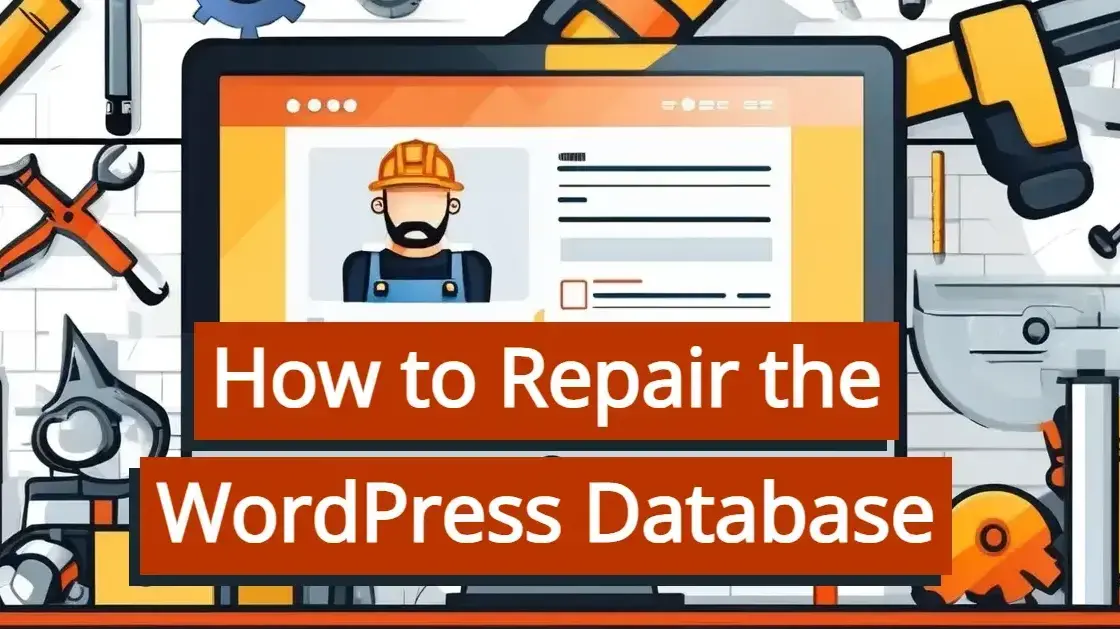When it comes to WordPress site maintenance, sometimes you’ll need to repair the database. In this article, you’ll learn the reasons why you might need to repair the WordPress database, as well as instructions on how to do it. Please note that this article has options for repairing the WordPress database with and without a plugin.
Why Would You Need To repair The WordPress Database?
Repairing a WordPress database might be necessary for several reasons, as the database is the backbone of your WordPress site, storing all its content, settings, and user information. Here are eight reasons why you might need to repair the WordPress database:
Corrupted Database Tables
Frequent Database Connection Errors
Site Performance Issue
Missing or Incomplete Data
Database Errors During Backup or Migration
Inability to Install or Update Plugins/Themes
Unusual Behavior in the WordPress Dashboard
WordPress Database Needs Optimization
Corrupted Database Tables
Over time, database tables can become corrupted due to various reasons like server crashes, hardware failures, or improper shutdowns. This corruption can lead to errors, slow performance, or data loss, making a database repair necessary.
Frequent Database Connection Errors
If you frequently encounter errors like "Error establishing a database connection," it could indicate issues with the database's integrity. Repairing the database can resolve these connection problems.
Site Performance Issues
A slow or unresponsive WordPress site can sometimes be traced back to a bloated or fragmented database. Repairing the database can optimize its performance by cleaning up unnecessary data and fixing structural issues.
Missing or Incomplete Data
If you notice that posts, pages, or other content are missing or incomplete, it could be due to corrupted database entries. Repairing the database might recover this missing data.
Database Errors During Backup or Migration
When backing up or migrating a WordPress site, database errors can occur if the database is damaged or improperly structured. Repairing it ensures that the backup or migration process goes smoothly without data loss.
Inability to Install or Update Plugins/Themes
Sometimes, errors during plugin or theme installation or updates are caused by issues in the database, such as missing or corrupted tables. Repairing the database can resolve these issues and allow for successful installations or updates.
Unusual Behavior in the WordPress Dashboard
If your WordPress dashboard starts behaving unpredictably—such as settings not saving, widgets not working, or menu items disappearing—it could be due to database problems. Repairing the database can often fix these inconsistencies.
WordPress Database Needs Optimization
Over time, a WordPress database can become bloated with unnecessary data, like revisions, spam comments, and transients. Regular repair and optimization help keep the database clean, ensuring better performance and reducing the risk of future issues.
Repairing the WordPress database can be a crucial step in maintaining the health, performance, and reliability of your website. It's important to regularly monitor and maintain your database to prevent potential problems before they escalate.
How to Repair the WordPress Database - Using Code and cPanel
Repairing the WordPress database using phpMyAdmin is a relatively straightforward process. Here’s a step-by-step guide to help you through it:
Backup WordPress Site
Access phpMyAdmin
Select Your WordPress Database
Check All Tables for Errors
Repair the Tables
Verify WordPress Site Functionality
Backup Your Database
Ongoing Maintenance
Step 1: Backup WordPress Site
Before making any direct changes to the WordPress database using phpMyAdmin, it’s super important to backup the site. This will give a save point in case things go sideways when making changes. Feel free to check out our article here at Verpex on backing up WordPress.
Step 2: Access phpMyAdmin
Login to your web hosting control panel. This is often cPanel, Plesk, or another hosting management dashboard provided by your web host. Here at Verpex, we use cPanel for most of our hosting packages, including our shared hosting.
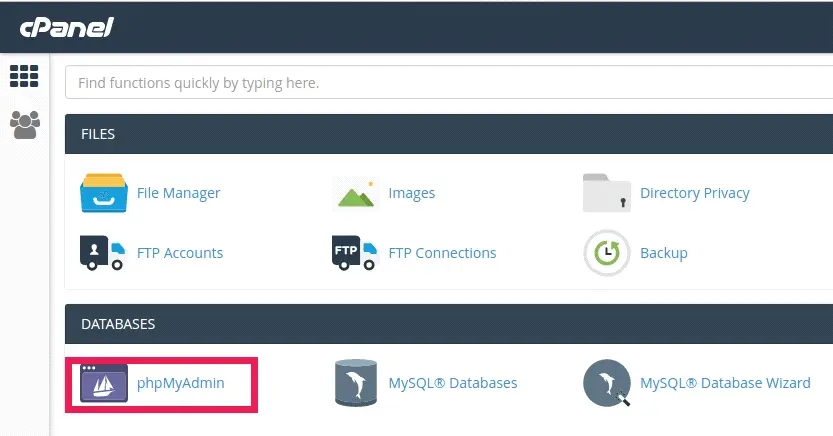
Locate phpMyAdmin. In your hosting control panel, for example, cPanel, look for the Databases section, and click on phpMyAdmin to open it.
Step 3: Select Your WordPress Database
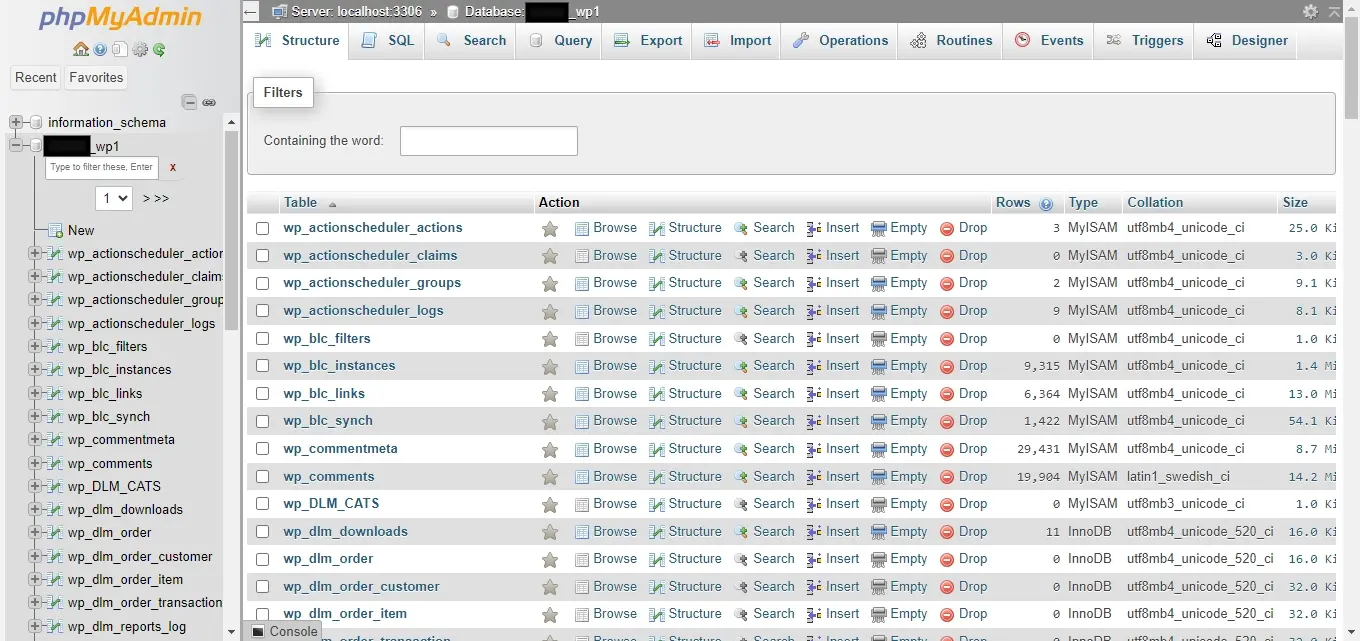
In phpMyAdmin, you’ll see a list of databases on the left sidebar. Select the database that corresponds to your WordPress site. If you’re unsure of the database name, you can find it in the wp-config.php file located in the root directory of your WordPress installation. Look for the line:
define('DB_NAME', 'your_database_name');
Step 4: Check All Tables for Errors
Once you’ve located the right database, you’ll need to check the tables.Once you’ve selected your WordPress database, you’ll see a list of all the tables within it (example: wp_posts, wp_users, etc.).

At the bottom of the table list, click the Check All box to select all tables.
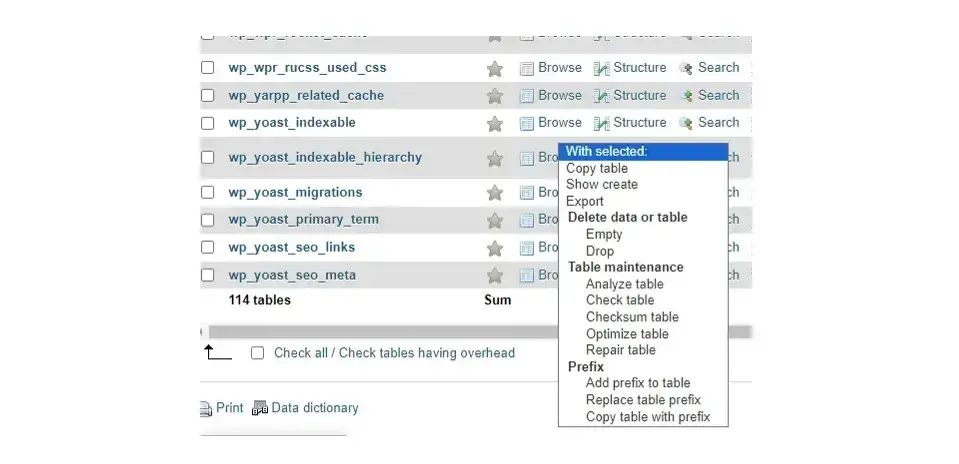
From the With selected dropdown menu, select Check table. This will check all the selected tables for errors.
Step 5: Repair the Tables
After checking, phpMyAdmin will display the status of each table. You will need to view the results. If any tables are reported as "in use" or having issues, proceed with the repair.
Select All Tables again and make sure that all tables are still selected by clicking the Check All box again. Choose the Repair Table option from the With selected dropdown menu. This will instruct phpMyAdmin to attempt to repair any corrupted tables.
After the repair process, phpMyAdmin will display the results, indicating whether the repair was successful or if there are any remaining issues. Make sure to review these results and repeat if necessary.
Step 6: Verify WordPress Site Functionality
Once the repair is complete, visit your WordPress site to make sure that everything is functioning properly. Make sure that the errors you were experiencing have been resolved, and check the overall performance of the site.
Step 7: Backup Your Database
It’s a good practice to create a backup of your repaired database. Even though you backed up your site before repairing, you should back it up once more after the repair was successful. In phpMyAdmin, you can do this by selecting the database, clicking the Export tab, and following the prompts to download a backup. However, you can also use a WordPress backup plugin to do the same thing.
Step 8: Ongoing Maintenance
To avoid future issues, periodically check and repair your WordPress database, especially if you notice any performance problems or errors. By following these steps, you can effectively repair your WordPress database using phpMyAdmin, ensuring that your website remains stable and performs well.
How to Repair the WordPress Database - Using a Plugin

Using WP-Optimize to repair and optimize your WordPress database is a user-friendly way to maintain your site’s database health. Here’s a step-by-step guide on how to do it:
Backup Your Site
Install and Activate WP-Optimize Plugin
Access WP-Optimize Dashboard
Review the Database Cleanup Options
Perform Database Optimization and Repair
Review Results
Schedule Regular Cleanups (Optional)
Step 1: Backup your Site
Make sure to backup your WordPress site before using this plugin. The WP-Optimize plugin has direct access to performing important database tasks, and if you select the wrong options, you may end up deleting important data from your site, like posts or pages.
Step 2: Install and Activate WP-Optimize Plugin
Log in to your WordPress Admin Dashboard by visiting yourwebsite.com/wp-admin. Navigate to Plugins in the left-hand sidebar and then select Add New.
To find WP-Optimize and install it, in the search bar, type WP-Optimize and hit Enter on your keyboard. Locate the WP-Optimize - Clean, Compress, Cache plugin from the search results, and then click the Install Now button next to the plugin.
Once you've activated the plugin, click Activate to enable the plugin on your site.
Step 3: Access WP-Optimize Dashboard
Now that you’ve installed and activated WP-Optimize, you’ll be able to find the plugin’s tools in the left-hand sidebar of the WordPress admin area. You will now see a new menu item labeled WP-Optimize. Click on it to open the plugin’s dashboard.
Step 4: Review the Database Cleanup Options
In the WP-Optimize dashboard, click on the Database tab. This section provides options for cleaning and repairing your database.
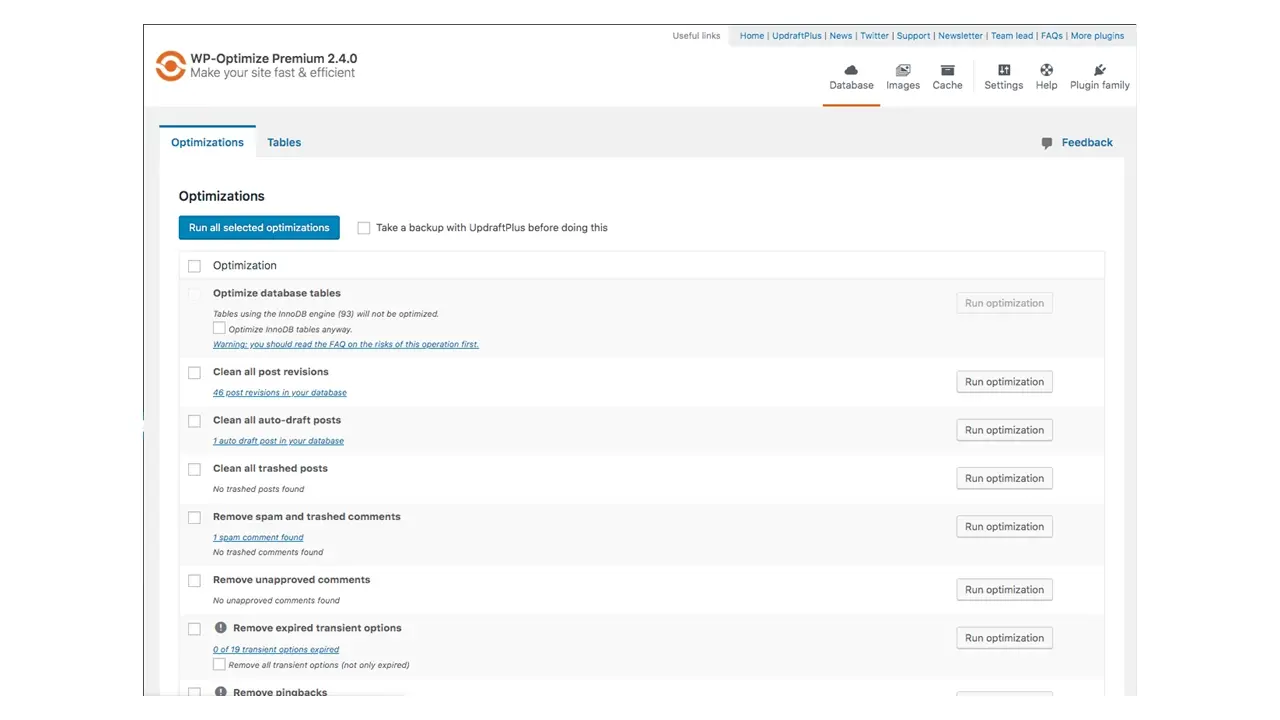
WP-Optimize offers several cleanup options, including:
Remove Post Revisions: Deletes old post revisions to reduce database size.
Remove Drafts and Auto-Drafts: Cleans up drafts and auto-drafts.
Remove Spam and Trash Comments: Deletes spam and trashed comments.
Optimize Tables: Optimizes database tables to improve performance.
Repair Tables: Repairs any corrupted tables in the database.
Step 5: Perform Database Optimization and Repair
Check the boxes next to the options you want to perform. For example, to repair your database, ensure the Optimize Tables box is selected. When you’ve selected the tasks you’d like the plugin to perform, click the Run all selected optimizations button to start the process. WP-Optimize will execute the selected cleanup and optimization tasks on your database.
Once you’ve clicked the button to start all the process, it’s time to wait for the plugin to do its job. The plugin will display a progress message and notify you when the process is complete. It may take a few moments depending on the size of your database.
Step 6: Review Results
After the process finishes, WP-Optimize will provide a summary of the actions taken and any improvements made to your database. Make sure to visit your WordPress site to make sure everything is functioning correctly. Check for any issues or improvements in performance.
Step 7: Schedule Regular Cleanups (Optional)
WP-Optimize allows you to schedule automatic cleanups to keep your database optimized regularly. Go to the WP-Optimize settings and configure the scheduling options according to your preference.
In Summary
If you ever need to repair the WordPress database, now you know why you might need to do so, as well as a few options to perform the task. Hopefully this article has helped. Just remember that it’s really important before repairing the database to back it up, no matter if you’re doing it directly in phpMyAdmin or using a plugin.
Frequently Asked Questions
Can WordPress be used for eCommerce?
WordPress offers many different ways to build an eCommerce online store for all types of products and markets. Almost 40 percent of all online shops are powered by WooCommerce, a WordPress eCommerce plugin.
Why choose Verpex for WordPress?
As the leading CMS out there, we’ve made it our mission to offer the most comprehensive and streamlined WordPress solutions on the market. Backed by a responsive customer care team and reliable site enhancement tools, we ensure our users get the full WordPress value and support for a reasonable price.
Why choose hosting for WordPress ?
WordPress is so popular because it allows people to create websites with total customization. With hundreds of apps available for one-click installations, creating something that’s eye-catching and unique is much easier with a CMS like WordPress. Learn more about WordPress optimized Hosting here.
What is metadata in WordPress?
Metadata, or meta tags, are small pieces of code embedded in a webpage's HTML that provide search engine bots with additional details about the page's content.

Nile Flores is a long time professional blogger, as well as WordPress website designer and developer from the St. Louis Metro East. Nile blogs at NileFlores.com, where she’s passionate about helping website owners, whether they’re small business owners or bloggers. She teaches about Blogging, Social Media, Search Engine Optimization, Website Design, and WordPress. Additionally, Nile loves to speak at WordCamps (WordPress conferences) across the United States. When Nile isn’t knee-deep in coding, she’s a proud mom of a college student, and enjoys oil painting, cigar smoking, nail art design, and practicing traditional Okinawan kempo karate.
View all posts by Nile Flores















